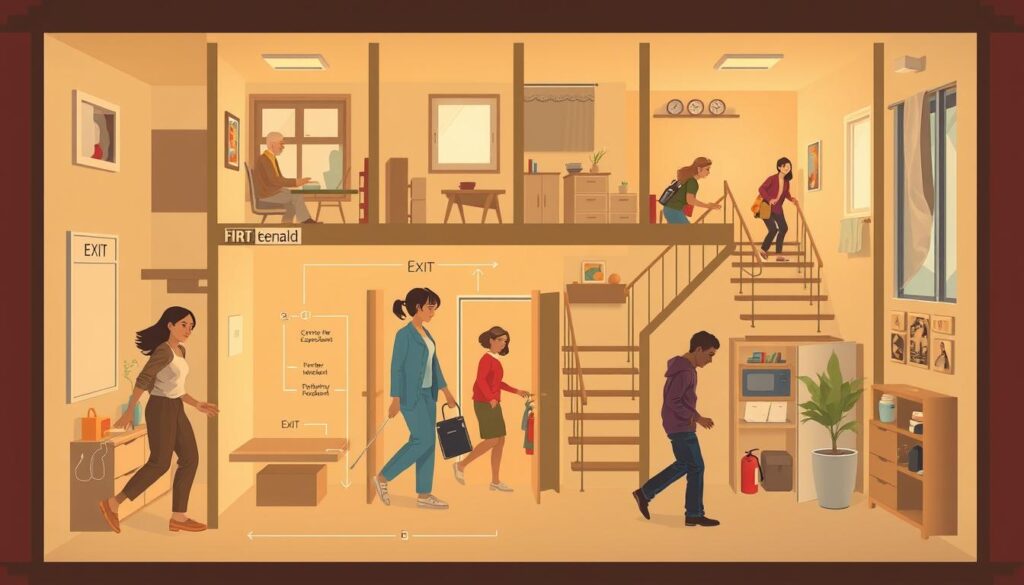Are you prepared in case of a fire emergency in your home? A well-thought-out escape plan can be the difference between life and death when seconds count.
In a smoky, disorienting atmosphere, it’s easy to freeze or panic. However, with a pre-planned escape route and regular practice, you and your family can be more confident about escaping safely.
Having a comprehensive escape plan in place is crucial for every family to protect lives during emergencies. This guide will walk you through the process of creating an effective plan tailored to your home’s layout and your family’s specific needs.
Key Takeaways
- Understand the importance of having a household emergency plan.
- Learn how to create an escape plan tailored to your home.
- Discover the essential elements of an effective escape strategy.
- Find out how to practice your plan regularly.
- Gain practical tips from fire safety experts.
Why Your Family Needs a Fire-Escape Plan
Ensuring your family’s safety during a fire requires a clear and practised escape plan. By planning and practising how you’ll escape with the whole family, you can be more confident about a safe escape, especially if someone in your home might find it difficult to escape quickly without assistance.

The Life-Saving Importance of Preparation
A well-designed fire-escape plan serves as a life-saving roadmap that guides your family to safety during the chaos of a house fire. Preparation is key to preventing panic and ensuring that everyone knows what to do in an emergency.
How a Plan Prevents Panic in Emergencies
Without proper preparation, panic can set in during emergencies, leading to poor decision-making. A comprehensive escape plan accounts for various scenarios, creating peace of mind and ensuring your family’s safety in the home.
- A comprehensive plan accounts for fires starting in different areas or during nighttime.
- Homes with rehearsed escape plans have significantly better outcomes during fire emergencies.
- Having a plan creates peace of mind, knowing exactly what to do in case of a fire.
The few minutes spent creating and practising a fire-escape plan could be the most important investment in your family’s life safety.
How to Create Household Fire-Escape Plan
To safeguard your family, it’s essential to develop a comprehensive household fire-escape plan. This plan will help ensure everyone’s safety in case of a fire emergency.
Identifying Primary and Secondary Exit Routes
Begin by drawing a simple floor plan of your home, marking all possible exits from each room, including doors and windows. For each bedroom, identify at least two escape routes—the primary door exit and an alternative such as a window or secondary door.

Designating a Safe Meeting Point Outside
Choose a safe meeting place a safe distance from your home where everyone should gather after escaping. This could be a neighbour’s house, a specific tree, or a landmark.
Accounting for Household Members with Special Needs
Make sure your plan accounts for household members with special needs, including elderly relatives, people with mobility issues, or young children who may need assistance.
| Escape Plan Component | Description |
|---|---|
| Primary Exit Route | Main door or usual exit |
| Secondary Exit Route | Alternative exit, such as a window or secondary door |
| Safe Meeting Point | A designated safe location outside the home |
Essential Elements of an Effective Escape Strategy
An effective escape plan is the cornerstone of home fire safety. It ensures that all household members can exit quickly and safely in case of a fire.
Smoke Alarm Placement and Maintenance
Functioning smoke alarms are crucial for early fire detection. Ensure you have smoke alarms on every level of your home and in each bedroom. Test them monthly and replace batteries at least once a year.
Keeping Exit Routes Clear and Accessible
Keep all exit routes clear of furniture, toys, and other obstacles. This is especially important in hallways and near doors and windows to facilitate a quick escape.
Storing Keys in Accessible Locations
Store door and window keys in consistent, accessible locations known to all household members. Consider using hooks near doors or designated containers that everyone can easily find, even in the dark or through smoke. For more information on creating a comprehensive escape plan, visit https://www.ready.gov/home-fire-escape-plan.
Practising Your Fire-Escape Plan
To guarantee a swift evacuation, it’s essential to regularly practise your fire-escape plan with all household members. Practising your plan helps ensure everyone knows what to do in case of a fire.
Conducting Regular Home Fire Drills
Schedule and conduct regular fire drills at least twice a year, including both daytime and nighttime scenarios. This ensures everyone knows what to do regardless of when a fire might occur.
Teaching Children What to Do During a Fire
Teach children to stay low where the air is clearer when moving through smoke and demonstrate the “stop, drop, and roll” technique if clothing catches fire. Ensure they understand not to hide during a fire or return to the building once they’ve escaped.
Timing Your Escape: The Two-Minute Rule
Time your practice drills to get everyone out of the house and to the designated meeting point within two minutes. Fire can spread rapidly, making quick evacuation essential.
Conclusion: Being Prepared Can Save Lives
In the event of a fire, having a well-practised escape plan can be the difference between life and death. To ensure your family’s safety, it’s crucial that everyone understands the plan and knows what to do in an emergency. When a fire breaks out, don’t waste time investigating or rescuing valuables – get out, stay out, and shut the doors behind you.
Call 999 as soon as you’re safe to do so. Regularly practising your fire-escape plan and reviewing it whenever there are changes to your home or family composition can make a critical difference in keeping your loved ones safe. By being prepared, you can ensure a safe escape in case of a fire.



